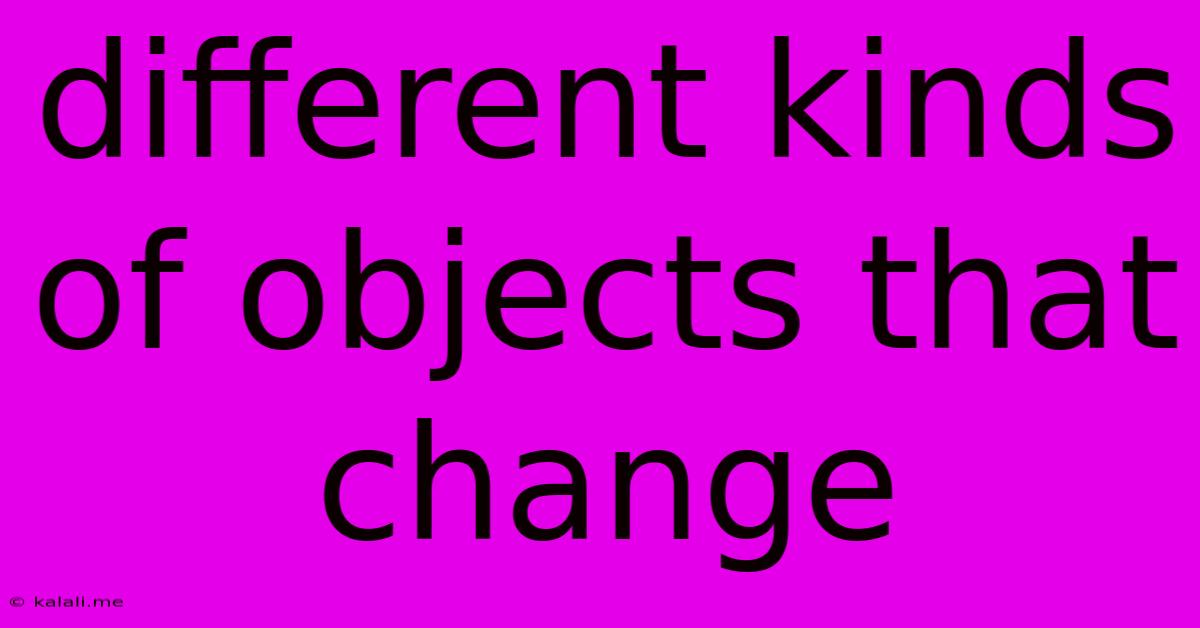Different Kinds Of Objects That Change
Kalali
Jun 07, 2025 · 3 min read

Table of Contents
Different Kinds of Objects That Change: A Comprehensive Overview
Meta Description: Explore the fascinating world of change! This article delves into various object types and how they transform, covering physical, chemical, and even conceptual changes. Discover examples from everyday life and scientific phenomena.
Change is a fundamental aspect of the universe. Everything around us, from the smallest particles to the largest celestial bodies, is in a constant state of flux. This article examines diverse types of objects and the myriad ways they undergo transformation, encompassing physical, chemical, and even conceptual alterations.
Physical Changes: Altering Form Without Changing Substance
Physical changes involve alterations in the form or appearance of an object without changing its chemical composition. The substance remains the same; only its physical properties are modified. Examples abound in our daily lives:
- Phase Transitions: Water, for instance, can exist as ice, liquid water, or steam—all different phases of the same substance (H₂O). These transitions are driven by changes in temperature and pressure. Similarly, the melting of wax, freezing of milk, and sublimation of dry ice are all examples of physical change.
- Shape Changes: Bending a paper clip, cutting a piece of wood, or crushing an aluminum can are all physical changes. The material itself remains unchanged; only its shape is modified.
- Size Changes: Expanding a balloon, stretching a rubber band, or compressing a spring are further examples of alterations in size, again without altering the chemical makeup of the objects.
- Mixing: Dissolving sugar in water is a physical change. While the sugar seems to disappear, it's still present—you can retrieve it by evaporating the water. This is different from a chemical change, where the original substance is transformed into something new.
Chemical Changes: Transforming Substances
Chemical changes, also known as chemical reactions, involve the transformation of one or more substances into entirely new substances with different chemical properties. These changes are often irreversible and are accompanied by observable phenomena like color change, heat release (exothermic), or heat absorption (endothermic).
- Burning: Combustion, like burning wood or gas, is a chemical change. The original substances are converted into ash, gases (carbon dioxide, water vapor), and other products.
- Rusting: The oxidation of iron (rust) is a classic example of a chemical change. Iron reacts with oxygen and water to form iron oxide, a completely different substance.
- Cooking: Many cooking processes involve chemical changes. Baking a cake, for instance, involves complex chemical reactions between ingredients, resulting in a new product that's vastly different from the individual components.
- Digestion: The breakdown of food in our bodies is a series of chemical changes where complex molecules are converted into simpler ones for absorption.
Conceptual Changes: Shifting Ideas and Perspectives
Beyond physical and chemical transformations, we can also consider conceptual changes – shifts in ideas, perspectives, and understanding. These aren't tangible objects in the traditional sense, but they are equally significant forms of change.
- Technological Advancements: The evolution of technology, from the invention of the wheel to the development of artificial intelligence, represents a constant state of conceptual change.
- Scientific Discoveries: New scientific discoveries reshape our understanding of the world, leading to conceptual shifts in various fields.
- Artistic Movements: Throughout history, artistic movements have reflected and driven conceptual changes in aesthetics, perspectives, and cultural values.
- Social and Political Change: Shifts in societal norms, political ideologies, and social structures are all examples of profound conceptual changes.
Understanding the different kinds of changes that objects undergo is crucial for comprehending the dynamic nature of our world. From the simplest physical alterations to the most complex chemical reactions and even the evolution of ideas, change is a constant and fundamental process that shapes our reality.
Latest Posts
Latest Posts
-
Can Incholate Crimes Involver A Minor Pretending To Be Someone
Jun 07, 2025
-
How Should Dispose Of Old Clogged Dryer Vent Piping
Jun 07, 2025
-
Did Both Thieves On The Cross Mock Jesus
Jun 07, 2025
-
Error Could Not Find Or Load Main Class User Jvm Args Txt
Jun 07, 2025
-
Walking Dead What Does Jss Mean
Jun 07, 2025
Related Post
Thank you for visiting our website which covers about Different Kinds Of Objects That Change . We hope the information provided has been useful to you. Feel free to contact us if you have any questions or need further assistance. See you next time and don't miss to bookmark.